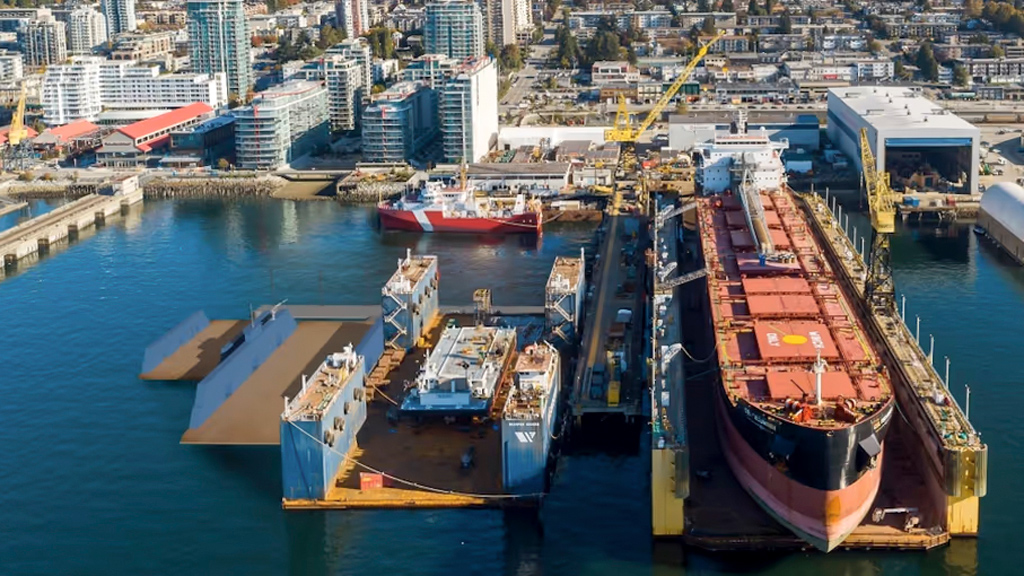Vancouver Drydock Company Ltd. Partnership (Seaspan) has received approval from the Vancouver Fraser Port Authority (VFPA) to expand and upgrade its North Vancouver drydock water lot facilities at 203 East Esplanade.
The expansion will add 100 new jobs to its 200-man drydock operation, but the approval comes with 61 imposed permit conditions.
The expansion received heavy opposition from North Vancouver’s mayor, First Nations, local residents and the area’s MP Jonathan Wilkinson, who is the federal energy and natural resources minister, with concerns ranging from noise to environmental impact.
The expansion is occurring on federal lands leased by Seaspan but managed by the VFPA. Seaspan is seeking the expansion as it will increase the capacity of the drydock to service additional vessels and would consolidate vessel repair activities at the drydock location adding capacity for shipbuilding at Seaspan’s Pemberton Avenue location.
Andrea MacLeod, VFPA director of project and environmental review, said in her Oct. 3 letter informing Seaspan of project approval, that the expansion was in an area that was designated for industrial use within the port authority land use plan and while residential encroachment had occurred near the site it has been historically used for industrial.
“The concerns of the City of North Vancouver and Indigenous groups, as well as the potential environmental effects, have been appropriately addressed through mitigation measures and the conditions included in the project permit,” she said.
The work is expected to take four months.
According to Seaspan’s public hearing information, it will consist of several components. The first portion involves shifting the existing careen floating drydock, used for tilting vessels for bottom repairs, approximately 40 metres south, away from the shoreline and installing two smaller floating drydocks. A work pontoon will be built on the west side of the operation, adjacent to the careen drydock.
The floating drydocks and work pontoon would be secured to six permanent support pilings.
The new mid-sized drydock would be equipped with up to four cranes mounted on the sidewalls of the drydock to transfer equipment to the main service pier to the work areas.
The second portion of the work includes extending Seaspan’s water lot west by approximately 40 metres to accommodate the smaller of the two new drydocks and a portion of the work pontoon.
“This is consistent with our existing lease agreement with the port authority,” Seaspan said in public information released.
The Project and Environmental Review (PER) permit application for Vancouver Drydock to the VFPA sets out the following work: installation of six new steel piles; two new drydocks, with one large drydock measuring approximately 100 metres in length by 30 metres in width and 10 metres in height, and one small drydock measuring 55 metres in length and 22 metres in width and eight metres in height; the installation of a new work pontoon measuring 98 metres in length and 13 metres in width and four metres in height; the installation of three ramps to connect the work pontoon to the drydocks and to the pier; installation or relocation of utilities including water, electrical, stormwater and process water; installation or relocation of lights; installation of four seasonal suspended herring spawn panels on the service pier, or at other suitable locations within the water lot; installation and use of several types of noise mitigation measures, including mobile panels and curtains as well as installation of equipment to monitor noise and environmental impact.
Under the permit issued, work must begin before Sept. 30, 2024 and be completed by Sept. 30, 2026.
The 61 conditions include a section which outlines elements of construction, such as the hours and days when construction can be carried out, the ability of First Nations to monitor the site, placement of trailers and barges and pile driving.
“Vibratory pile installation is recommended as the primary method used for pile installation works,” condition 37 sets out.
If impact pile driving is required there are a series of noise mitigation measures that have to be observed by the contractor.
“Prior to the commencement of pile installation (vibratory or impact), the permit holder shall hire a qualified vibration consultant to instrument and monitor any potential ground vibrations adjacent to the foundation of the nearest building,” the requirements read.
No figures have been released on the cost of the expansion, however, B.C.’s government has made available $25 million in grants for marine infrastructure upgrades. The funds are being administered through the Association of Marine Industries, which has had its first intake of projects and will take in a second round of expressions of interests will starting Nov.1 with full proposals submitted by Feb. 15, 2024 and funding decisions by March 8, 2024.
Smaller projects can receive up to 50 per cent of capital costs up to $500,000 while larger capital projects can receive up to 25 per cent of a $5 million capital cost.







Recent Comments
comments for this post are closed